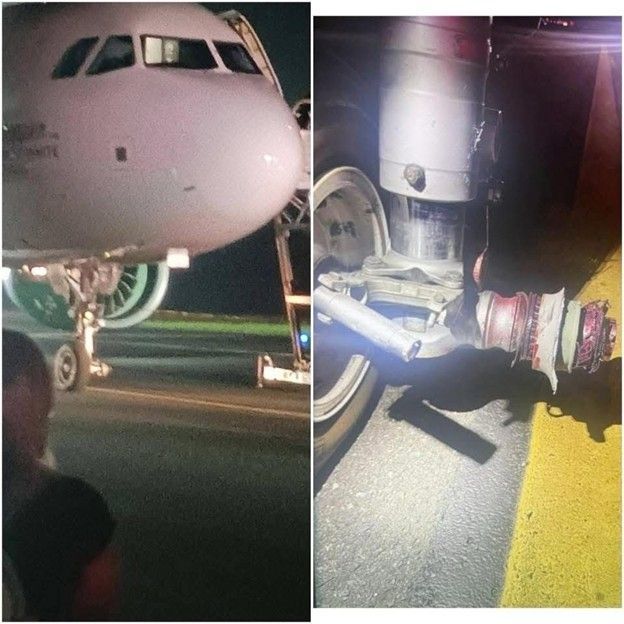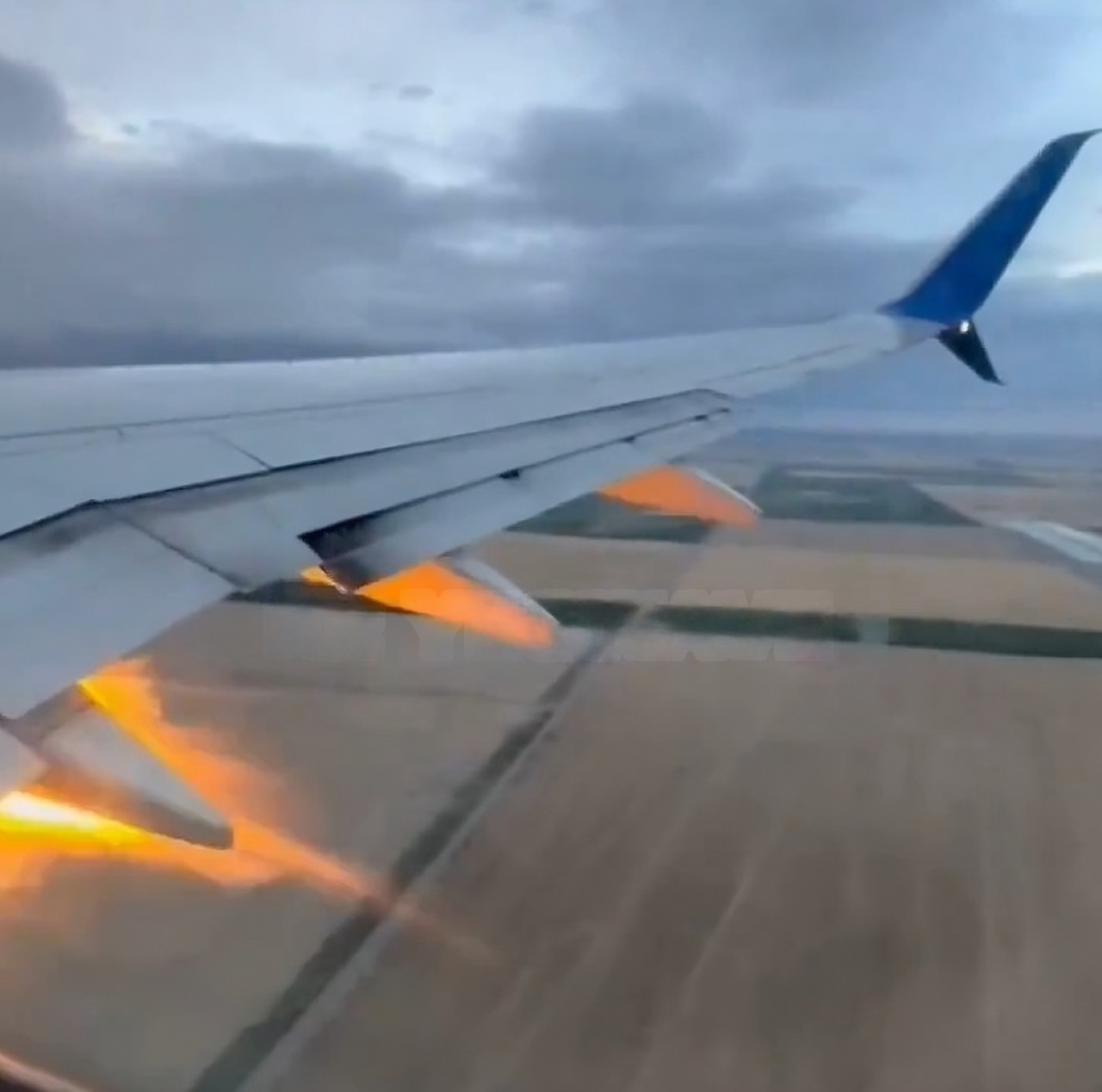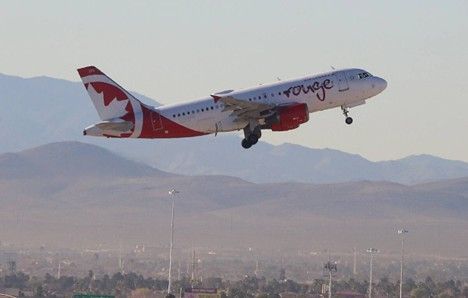ARFF Daily News
Published on:
Thursday the 17th of April, 2025
Hard Landing, Flaming Engine—San Juan Shuts Runways As Frontier A321neo Nails Second Touchdown
by Gary Leff on April 16, 2025
On Tuesday evening, Frontier Airlines Flight 3506 from Orlando was coming in to land in San Juan when the Airbus A321neo touched down hard on runway 10. Passengers described it as “shocking” and “horrible.”
The crew then executed a go-around, heading back into the air to reassess the aircraft’s status. During the climb-out, a continuous stream of flames emitted from the aircraft’s left engine. However despite initial reports and panic among passengers, there was no fire actually aboard the aircraft.
The airport closed both its primary runways, warning inbound aircraft about debris on the runways. Several incoming flights were put into holding patterns, with two flights diverted back to Fort Lauderdale and three to diverted to Aguadilla, Puerto Rico.
Flight crew of Frontier 3506 worked through landing-gear safety checklists. Then 27 minutes after the first landing attempt, the aircraft executed a low-altitude approach to runway 8 for inspection. About 40 minutes after the initial hard touchdown, the flight landed safely there, stopped on a parallel taxiway for inspection, and took the plane’s 228 passengers and crew off the runway area.
The Federal Aviation Administration categorized the event as a hard landing incident resulting in damage to the aircraft’s landing gear.


‘Loud Bang And A Giant Fireball’ United Flight Returns To Denver After Rabbit Strike Ignites Engine During Takeoff
by Gary Leff on April 16, 2025
United Airlines flight 2325 suffered an unusual wildlife strike on Sunday shortly after the Boeing 737-800 departed from Denver. The plane, which was carrying 153 passengers and six crew, hit a rabbit.
The Edmonton, Alberta-bound flight took off from runway 34L and the airline reported a possible rabbit strike to the plane’s right-hand CFM56 engine. Passengers heard a loud explosion followed by significant vibrations. Large flames were seen shooting from the right engine, causing panic inside the cabin. One witness explains,
There was a loud bang and a significant vibration in the plane. We proceeded to still climb. Every few moments, there was a backfire coming from the engine, a giant fireball behind it. Everybody in the plane then started to panic.
Pilots declared a Mayday emergency, informed controllers that they had lost the right-hand engine and were managing an engine fire near the wing. The aircraft entered a holding pattern, allowing the flight crew time to run through emergency checklists. Approximately 40 minutes after departure, the aircraft safely landed back at Denver International Airport on runway 34L. Emergency responders were on standby, but no one was injured.
The aircraft returned to the gate, and passengers were moved to another Boeing 737-800, arriving in Edmonton about 3 hours late.
To be sure, planes like this can fly with a single engine. Nonetheless, I’ve been on a Boeing 737-800 that struck a bird on takeoff, ingesting it into an engine, and having to return back to origin. It was frightening. You could hear a loud bang, the engine powered down and the captain came on letting us know we’d be turning around. The entire cabin was silent, and you’ve never seen a plane get such a direct routing into a major hub before. We landed and were surrounded by emergency vehicles. There was a visual inspection done of the aircraft, before we were allowed to taxi back under our own power.
Bird strikes are relatively common. They fly in the path of aircraft. Rabbit strikes aren’t so common because rabbits do not fly.
The only other known incident that this 27-year old former Continental 737 has had was coincidentally similar, a bird strike on departure from San Francisco. That time it was a turkey vulture.

Air Canada flight from Las Vegas makes emergency landing in Iowa
By Bryan Horwath - Las Vegas Review-Journal
An Air Canada flight from Las Vegas’ Harry Reid International Airport to Toronto made an emergency landing in Iowa on Wednesday, according to an airline spokesperson.
In an email, the spokesperson said Air Canada Rouge Flight 1702 was forced to divert to Des Moines International Airport on Wednesday following an odor of smoke that was “detected in the flight deck.”
No injuries were reported, the spokesperson said. The Airbus A321 plane had 176 passengers.
A different aircraft was sent to bring passengers to their final destination in Toronto, the spokesperson said. The cause of the smoky smell was not identified.
Air Canada Rouge is a subsidiary of Air Canada.
https://www.reviewjournal.com/local/local-las-vegas/air-canada-flight-from-las-vegas-makes-emergency-landing-in-iowa-3352723/

NTSB Prelim: AERO SP Z O O AT-4 LSA
According To A Witness, The Airplane Had Just Departed... When It Suddenly Descended And Struck The Ground At The End Of Runway 27
Location: Zellwood, FL Accident Number: ERA25FA154
Date & Time: March 22, 2025, 09:25 Local Registration: N8548U
Aircraft: AERO SP Z O O AT-4 LSA Injuries: 1 Fatal
Flight Conducted Under: Part 91: General aviation - Personal
On March 22, 2025, about 0925 eastern daylight time, a Aero SP Z O O AT-4 LSA, N8548U, was substantially damaged when it was involved in an accident near Zellwood, Florida. The private pilot was fatally injured. The airplane was operated as a Title 14 Code of Federal Regulations Part 91 personal flight.
According to a witness, the airplane had just departed from Bob White Field (X61), Zellwood, Florida, when it suddenly descended and struck the ground at the end of runway 27. The witness stated that the airplane immediately caught fire upon impact with the terrain, but it was not on fire prior to the impact. A second witness reported watching the airplane taxi to the departure end of the runway and waived to the pilot. This witness reported that the airplane appeared to be “normal”, and the canopy appeared to be down.
The accident site was located at the western end of the runway in a drainage ditch. The initial impact scar was about 3 feet to the east of the main wreckage. The impact crater was oriented on a 285° heading and was about 6 ft-long. Horizontal marks in the sandy terrain extended outwards from the impact crater that were 10 ft in length. The airplane was inverted oriented along a 120° heading. All major parts and components of the airplane remained with the main wreckage.
The pilot’s seatbelt, the airplane canopy and windscreen, magnetic compass, and one propeller blade were located past the main wreckage on the western side of the drainage ditch. Part of the canopy structure was located at the top of the drainage ditch past the empennage, and about 20 feet from the impact crater with the securing pins, jettison levers, and locking levers attached to the pushrod assembly. The pilot’s seatbelt and fuselage connection points were about 40 feet from the main wreckage, and it remained latched at the buckle. The propeller blade was about 120 feet from the main wreckage.
The composite fuselage structure and cockpit instrumentation was consumed by postimpact fire. The control yokes remained attached within the fuselage. Control cable and tube continuity from the flight control surfaces to the control yoke and rudder pedals were visually established. The leading edges of both wings showed uniform crushing from the wing roots to the wing tips. The flaps were in the up position. The right wing was displaced slightly forward, and the left wing was displaced slight aft of the fuselage. The empennage was separated from the fuselage and was displaced to the right of the fuselage. The right main landing gear was displaced aft and into the bottom of the right wing, just forward of the flap. The left main landing gear was displaced aft and into the bottom of the left wing, just forward of the flap.
The nose landing gear was separated and was located below the fuselage debris. The four-cylinder engine was damaged by fire. The spark plugs remained installed in their respective cylinder heads. The intake system was separated from the cylinder heads on the left side of the engine. The alternator remained attached to the engine. The engine magneto was dislodged from its mounting surface and was destroyed by fire. The engine crankshaft rotated about 30° when force was applied to the propeller. No external signs of catastrophic engine failure were evident.
The airplane was equipped with a three-blade carbon fiber propeller. One propeller blade was broken at the propeller hub and was found at the end of the wreckage path, about 120 feet from the main wreckage. One propeller blade remained attached to the propeller hub but was splintered. One propeller blade was broken at the propeller hub and was found adjacent to the engine. Rotational scoring and leading-edge damage were present on the propeller blade located at the end of the wreckage path.
A review of the maintenance records revealed that the airplane’s most-recent annual inspection had been completed on March 18, 2025. A witness who stored their airplane in the hangar next to the accident airplane stated that the pilot had asked him to help secure the lower cowling back onto the airplane after the annual inspection was completed. The wreckage was recovered and retained for further examination.
FMI: www.ntsb.gov

Today in History
61 Years ago today: On 17 April 1964 Middle East Airlines flight ME444, a Caravelle, crashed while on approach to Dhahran Airport, Saudi Arabia, killing all 49 occupants.
Date: Friday 17 April 1964
Time: 19:32
Type: Sud Aviation SE-210 Caravelle III
Owner/operator: Middle East Airlines - MEA
Registration: OD-AEM
MSN: 23
Year of manufacture: 1960
Fatalities: Fatalities: 49 / Occupants: 49
Other fatalities: 0
Aircraft damage: Destroyed, written off
Category: Accident
Location: 19 km SSE of Dhahran International Airport (DHA) - Saudi Arabia
Phase: Approach
Nature: Passenger - Scheduled
Departure airport: Beirut International Airport (BEY/OLBA)
Destination airport: Dhahran International Airport (DHA/OEDR)
Confidence Rating: Accident investigation report completed and information captured
Narrative:
Middle East Airlines flight ME444, a Caravelle, crashed while on approach to Dhahran Airport, Saudi Arabia, killing all 49 occupants.
Flight ME 444 departed Beirut (BEY) at 17:09 UTC and climbed to its cruising altitude of FL300. At 19:04 the aircraft reported to Bahrain Control that it was estimating Dhahran (DHA) at 19:28, and was cleared to descend to reach FL50 over the Dhahran beacon. At 19:06 weather information was reported to flight 444, which read a NNE/10 knots wind, gusting to 16, and 0,5nm visibility (in a sandstorm). At 19:26 the pilot reported estimating the Dhahran NDB in two minutes. At 19:28 it contacted Dhahran and reported "5 000 feet descending" and was cleared for an ADF approach. The controller requested the crew to report at 4000 feet and outbound at 2000 feet. One minute later it reported leaving 4000 feet and at 19:30 passing 2500 feet and turning inbound. It was then cleared to final approach and requested to report reaching minimum and runway in sight. At approximately 19:32 a short loud transmission noise was recorded by the Tower. No further message was received from the flight. It was subsequently found that the aircraft struck the sea at the completion of the procedure turn 4 NM off shore and 10 NM south of Dhahran Airport.
The investigation team concluded that there was no mechanical failure that could have caused the accident. Several theories were investigated, a.o. erroneous radio altimeter indications as a result of the sandstorm (these effects have been proven in tests done by Air France), but the team was not able to prove any of those theories.
PROBABLE CAUSE: "The probable cause of this accident can not be ascertained."

